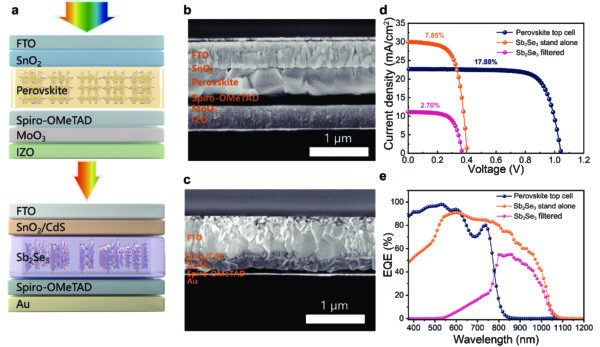A group of researchers at the University of Science and Technology of China has fabricated a four-terminal (4T) tandem solar cell based on a top cell relying on a perovskite absorber and a bottom device using an absorber made of antimony selenide.
“Antimony selenide is a suitable bottom cell material for tandem solar cells,” the scientists stated. “However, because of the rarity of reported tandem solar cells using it as a bottom cell, little attention has been paid to its application.”
Antimony selenide (Sb2Se3) is a p-type inorganic semiconductor with a one-dimensional crystal structure and a direct bandgap in the range of 1.2 eV to 1.9 eV. It has excellent optoelectronic properties. In recent years, it has also been used as an absorber material to build solar cells. The efficiencies achieved by such devices have reached between 5% and 9.2%.
These efficiency levels are still far behind those of other thin-film technologies, such as cells based on copper, indium, gallium and selenide (CISG), cadmium telluride (CdTe), kesterite (CZTSSe), and amorphous silicon (a-Si). This technological gap might depend on the fact that features such as mobility, carrier lifetime, diffusion length, defect depth, defect density and band tail remain largely unknown to the scientific community for the Sb2Se3 cell technology, as not too many devices of this kind have been fabricated to date.
The Chinese group presented its tandem cell in the study “Sb2Se3 as a bottom cell material for efficient perovskite/Sb2Se3 tandem solar cells,” published in Energy Materials and Devices, and said the key features of the device are the transparent conducting electrode they used to improve the spectral response of the top cell and the “double” electron transport layer (ETL) of the antimony selenide cell.
The academics designed the top cell with a substrate made of f-doped tin dioxide (FTO), an ETL made of tin oxide (SnO2), a perovskite absorber, a hole transport layer (HTL) based on Spiro-OMeTAD, a buffer layer made of molybdenum trioxide (MoO3), and a transparent contact based on indium zinc oxide (IZO).

Image: Energy Materials and Devices, Tsinghua University Press, Creative Commons License CC BY 4.0
The bottom cell was designed to have a substrate made of FTO, an ETL made of tin(IV) oxide (SnO2) and cadmium sulfide (Cds), the Sb2Se3 absorber, an HTL relying on Spiro-OMeTAD, and a gold (Au) metal contact.
“We successfully fabricated 4-T perovskite/Sb2Se3 tandem solar cells,” the scientists stated. “The IZO films prepared through magnetron sputtering generate both good conductivity and outstanding transparency.”
Tested under standard illumination conditions, the top cell achieved an efficiency of 17.88% and the bottom cell of 7.85%. “Ultimately, the power conversion efficiency of the 4-T perovskite/Sb2Se3 tandem solar cells reached 20.58%, which is higher than that of the independent subcells,” the scientists emphasized.
“Our work provides a new tandem device structure and demonstrates that antimony selenide is a promising absorber material for bottom cell applications in tandem solar cells,” concluded the research's lead author, Tao Chen.
This content is protected by copyright and may not be reused. If you want to cooperate with us and would like to reuse some of our content, please contact: editors@pv-magazine.com.




1 comment
By submitting this form you agree to pv magazine using your data for the purposes of publishing your comment.
Your personal data will only be disclosed or otherwise transmitted to third parties for the purposes of spam filtering or if this is necessary for technical maintenance of the website. Any other transfer to third parties will not take place unless this is justified on the basis of applicable data protection regulations or if pv magazine is legally obliged to do so.
You may revoke this consent at any time with effect for the future, in which case your personal data will be deleted immediately. Otherwise, your data will be deleted if pv magazine has processed your request or the purpose of data storage is fulfilled.
Further information on data privacy can be found in our Data Protection Policy.